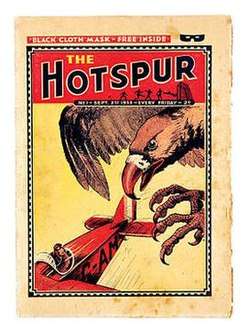The Hotspur
The Hotspur was a British boys' paper published by D. C. Thomson & Co. From 1933 to 1959, it was a boys' story paper; it was relaunched as a comic in October 1959, initially called the New Hotspur, and ceased publication in January 1981.
| Hotspur | |
|---|---|
 Issue 1 of Hotspur (1933) | |
| Publication information | |
| Publisher | D. C. Thomson & Co. |
| Publication date | 2 September 1933 |
Original Hotspur
The Hotspur was launched on 2 September 1933[1] as a story paper, the last of the 'Big Five'.[2] The first issue came with a black mask as a free gift[3][4] and contained an offer for an electric shock machine:
It's a great prize, absolutely harmless and will give hours of fun. Just watch your pal's face when you give him his first electric shock![5]
Thomson's 'Big Five' papers were extremely successful; the name was used by both readers and the industry.[6][7] In 1939 the company advertised combined weekly sales of over a million for the group; the first issue of The Hotspur sold over 350,000 copies.[8] The Hotspur specialised in school stories;[9] its Red Circle School stories replaced the public school stories in The Gem and The Magnet as reader favourites.[10][11]
Like other British children's publications, The Hotspur was published weekly, except for the Second World War and its aftermath, when as a result of paper rationing it published fortnightly,[12] alternating with The Wizard.[13] The original Hotspur story paper published 1197 issues, the last on 17 October 1959.
Notable characters and series
- Red Circle School, a public school with pupils from all over the world.[14][15]
- Bill Sampson, also known as The Wolf of Kabul, an agent of the British Intelligence Corps, first introduced in The Wizard, appeared in illustrated format in The Hotspur.[16]
The New Hotspur
It relaunched in comic format as the New Hotspur[17] on 24 October 1959, a week after the original series ceased publication, and ran for another 1110 issues until being incorporated into The Victor on 24 January 1981.[18][19] The new format contained comic strips as opposed to the old text story format. The word "new" in the title was dropped with issue #174. There had been several mergers during the 1970s: with The Hornet in 1976, and with The Crunch in 1980. In January 1981 The Hotspur finally merged with The Victor.[18]
Strips included:
- Coral Island
- Dozy Danny - eleven-year-old Danny Lorimer is constantly nodding off during the school day, as his stepfather forces him to get up at four o'clock in the morning every day to make coal briquettes.
- Jonny Jett
- King Cobra - journalist Bill King transforms into the UK's very own high-tech superhero. Drawn by Ron Smith.
- Spring Heeled Jack
- Union Jack Jackson, a British Royal Marine serving with the US Marine Corps in the Pacific campaign during World War II, later in Warlord.[20]
- X-Bow
References
- Vic Whittle, British Comics.
- Joseph McAleer, Popular Reading and Publishing in Britain 1914–1950, Oxford: Clarendon, 1992, ISBN 0-19-820329-2, p. 168.
- British Book News 1979, p. 296.
- Winter 2004 Market Report, Compalcomics.
- McAleer, p. 179.
- McAleer, p. 168. In addition to The Hotspur they were Adventure, The Rover, The Wizard and The Skipper.
- Roger Sabin, Comics, Comix & Graphic Novels: A History of Comic Art, London: Phaidon, 1996, ISBN 0-7148-3008-9, p. 44: "These papers in the 1920s and 1930s were dominated by the 'Big 5'.
- McAleer, p. 172, note 18; p, 172, Fig. 6.1.
- William Oliver Guillemont Lofts and Derek John Adley, The Men Behind Boys' Fiction, London: Howard Baker, 1970, ISBN 0-09-304770-3, p. 9.
- McAleer, p. 169.
- Jeffrey Richards, Happiest Days: The Public Schools in English Fiction, Manchester University Press, 1988, ISBN 0-7190-1879-X, p. 289: "In its heyday The Magnet had a weekly press run in excess of 200,000. By 1930 it had fallen to 120,000 as a result of the direct competition of D. C. Thomson papers. This became particularly serious in 1933 with the launch of The Hotspur and the appearance of Red Circle, a tougher, more rambustious and more up-to-date public school than Greyfriars . . . which wooed schoolboy readers away .... By 1940 the Magnet's circulation was down to 41,660 [while] Gem had by 1939 fallen to 15,800 copies a week".
- McAleer, p. 62.
- Hotspur at 26pigs.com.
- McAleer, p. 169.
- Dan O'Neill, "Wizard time to be a boy; Time to remember", South Wales Echo, 17 September 2001.
- Conroy, p. 158.
- Redesigned by its postwar editor, Jack Mackersie; McAleer, p. 163, note 3.
- Vic Whittle, Hotspur Page at British Comics.
- Kevin Carpenter, Penny Dreadfuls and Comics: English Periodicals for Children from Victorian Times to the Present Day: a loan exhibition from the Library of Oldenburg University, West Germany at the Bethnal Green Museum of Childhood, 2 June-2 October 1983, London: Victoria & Albert Museum, 1983, ISBN 0-905209-47-8, n.p..
- Mike Conroy, War Stories: A Graphic History, New York: Ilex/Harper, 2009, ISBN 978-0-06-173112-9, p. 116
External links
- The Hotspur at the Grand Comics Database
- "Japers of the Red Circle", the Red Circle School story from The Hotspur issue number 1, at Vic Whittle's British Comics site